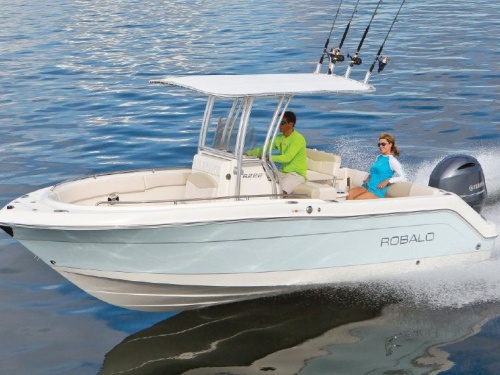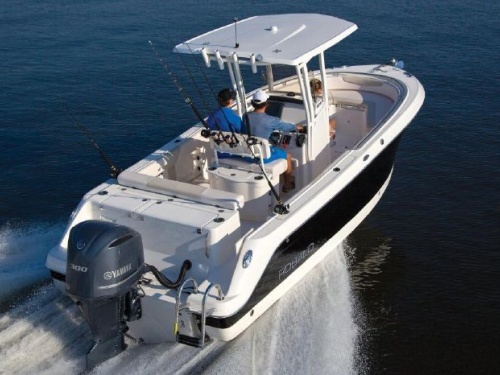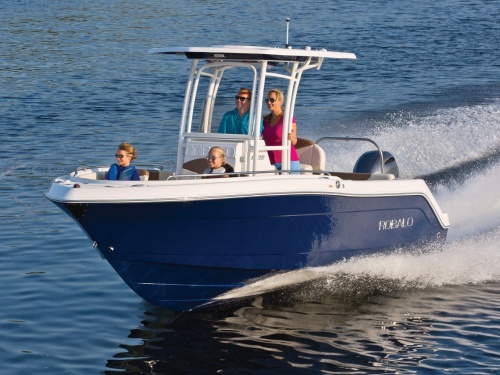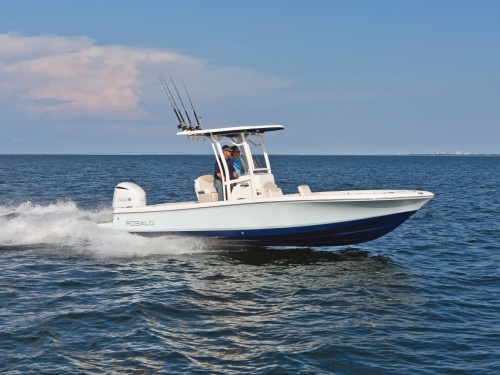Access More Boat Tests
Already have an account? Login
Robalo R242EX (2019-)
1 x 300-hp Yamaha F300UCA
Price
See the price by becoming
a BoatTEST member.
Members Must Log In
Brief Summary
The R242EX is Robalo’s latest addition to its Explorer series that introduces comfort features to a very fishable center console. The primary difference is the built-in aft bench seating that wraps the transom, the enhanced bow seating with swivel seat backs, and sophisticated glass dash on the helm console. The new Explorer also has 3-tone upholstery and a few other details that the family will like.
Key Features
- Aluminum-framed, wraparound, tempered safety glass windshield
- Deluxe helm seating with bolsters
- Two 36-gallon (136.3 L) bow fishboxes with overboard drains
- 16-gallon (3.79 m) aerated, recirculating livewell
- Forward opening head compartment
- Built-in aft L-shaped bench seating with livewell and storage beneath
- Forward table that converts to a casting platform or sun pad with a filler cushion
- Coaming bolsters forward, aft, and to the sides
- Dual battery system with crossover switch
- Battery charger
- Washdown system with forward and aft connectors
- Freshwater shower in cockpit
Test Results
| RPM | MPH | Knots | GPH | MPG | NMPG | STAT. MILE | NM | dBa |
|---|---|---|---|---|---|---|---|---|
| 600 | 3.6 | 3.1 | 0.6 | 5.5 | 4.8 | 693 | 603 | 64 |
| 1000 | 5.2 | 4.5 | 1.3 | 4.1 | 3.6 | 518 | 450.4 | 68 |
| 1500 | 7.2 | 6.3 | 2 | 3.5 | 3.1 | 446 | 387.7 | 71 |
| 2000 | 8.5 | 7.3 | 3.3 | 2.6 | 2.2 | 324 | 281.4 | 77 |
| 2500 | 10 | 8.7 | 5.4 | 1.9 | 1.6 | 233 | 202.8 | 80 |
| 3000 | 12.4 | 10.7 | 6.7 | 1.9 | 1.6 | 234 | 203.2 | 82 |
| 3500 | 24.2 | 21 | 8.1 | 3 | 2.6 | 375 | 325.9 | 88 |
| 4000 | 30.6 | 26.6 | 11.2 | 2.7 | 2.4 | 342 | 297.8 | 95 |
| 4500 | 34.7 | 30.1 | 14.3 | 2.4 | 2.1 | 306 | 266.4 | 88 |
| 5000 | 37.8 | 32.8 | 17.2 | 2.2 | 1.9 | 277 | 240.9 | 89 |
| 5500 | 42.2 | 36.7 | 21.6 | 2 | 1.7 | 246 | 214.3 | 96 |
| 6074 | 46.3 | 40.3 | 26.6 | 1.7 | 1.5 | 219 | 190.5 | 102 |
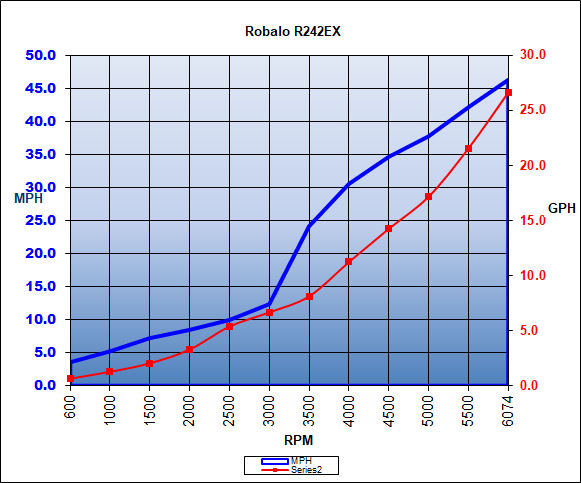
Specifications
| Length Overall | 24' / 7.32 m |
|---|---|
| Beam |
8' 9" 2.67 m |
| Dry Weight |
4,800 lbs. 2,177 kg |
| Tested Weight |
5,609 lbs. 2,544 kg |
| Draft | N/A |
| Draft Up |
20" 51 cm |
| Draft Down |
35" 89 cm |
| Deadrise/Transom | 22-degrees |
| Max Headroom | N/A |
| Bridge Clearance |
8' 7" 2.62 m |
| Weight Capacity | N/A |
| Person Capacity | 12 |
| Fuel Capacity |
156 gal. 591 L |
| Water Capacity |
13.5 gal. 51 L |
| Total Weight |
5,609 lbs. 2,544 kg |
Acceleration Times & Conditions
| Time to Plane | 3.5 sec. |
|---|---|
| 0 to 30 | 8.2 sec. |
| Ratio | N/A |
| Props | 17P SWS II |
| Load | 2 persons, 1/2 fuel, no water, 50 lbs. of gear |
| Climate | 60 deg., 42 humid.; wind: 10-15 mph; seas: calm |
Engine Options
| Tested Engine |
1 x 300-hp Yamaha F300UCA |
|---|---|
| Std. Power |
1 x 250-hp Yamaha Four Stroke F250UCA 30" 4.2L V6 Digital |
| Opt. Power |
1 x 300-hp Yamaha Four Stroke F300UCA 30" 4.2L V6 Digital |
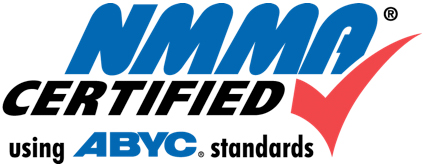 Learn More
Learn More
Watch Our Video
Contents of Report
Mission
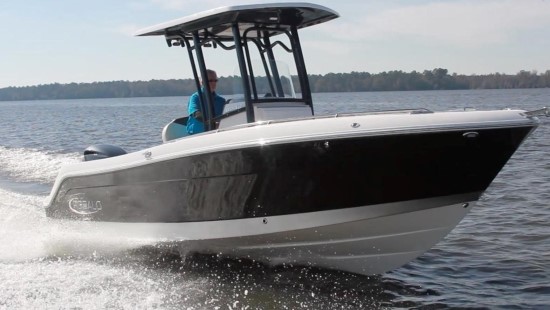
The Robalo R242EX is purposefully built for combining offshore fishing prowess with comfort for the family and fun on the water. That, together with a competitive price, should make this boat appealing to families who want a multi-use boat.
Major Features
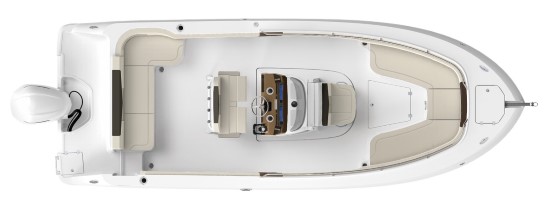
- • Glass-Dash Digital Helm. Optional single or dual Simrad 9” multifunction displays or optional single or dual Garmin 10” multifunctional displays
- • Fore and Aft Casting Platforms. Forward seating and aft L-shaped bench seating convert to casting platforms.
- • Improved Ground Tackle System. The anchor is set in a notch in bow, has a cleat on the centerline, and good rode locker access.
- • Built-in Swim Platform. Full width swim platform with covered re-boarding ladder and outboard well.
- • 36-Gallon Bow Fishboxes. Bow fishboxes with overboard drains.
- • Tempered Wraparound Windshield. With tempered glass, the windshield provides long-lasting clarity without crazing that can occur with acrylic windshields.
- • Published Pricing. Robalo offers prices directly online with options clearly priced and calculated with their online build-a-boat tool.
- • Freshwater Shower.
- • Fiberglass T-top with aluminum supports and grab rails
- • Yamaha Four Stroke F300UCA 30" 4.2L V6 300-hp Digital
- • Electric toilet with overboard discharge
- • Windlass package with galvanized anchor
- • Tandem axle, aluminum trailer with aluminum wheels
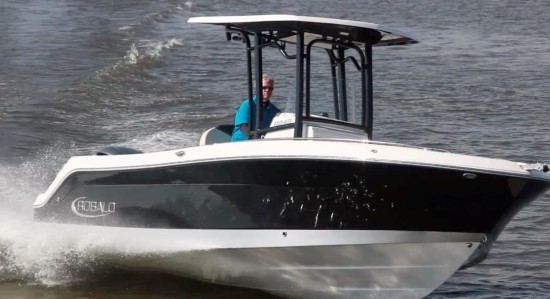
Top Speed. With a single 300-hp Yamaha 4-stroke turning a 15.5” three-blade Saltwater 2 propeller, the test boat reached a top speed of 46.3 mph at 6074 rpm.
Best Cruise. The best cruise came in at 3500 rpm and 24.2 mph. At that speed, the 8.1 gph fuel burn translated into 3.0 miles per gallon, and a range of 375 statute miles while still holding back a 10% reserve of the boat’s 140-gallon (530 L) total fuel capacity.
Acceleration Times and Test Conditions
Time to Plane: 3.5 seconds
0 to 20: 5.5 seconds
0 to 30: 8.2 seconds
Prop: 15.5” three-blade Saltwater 2
Load: Two people, 45% fuel capacity, no water, 50 lbs. of gear
Conditions: 60-degrees, moderate wind (10-15 mph), no chop, freshwater
Handling
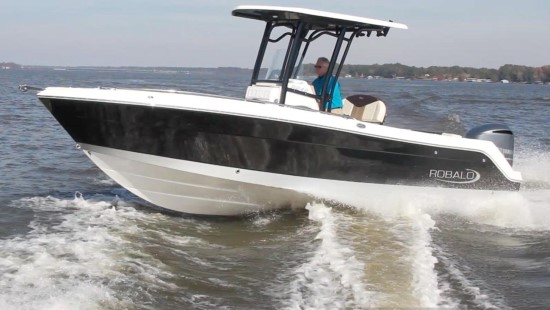
Designed with what Robalo brands as the Hydro-Lift hull, the R242EX has a solid, dry ride. The sharp bow entry is sharp to cut through waves and not pound, and the variable deep-V hull culminates with a 22-degree deadrise at the transom. This is a good compromise between ride quality and efficiency, with the scale slightly tipped to ride cushioning.
Upon hitting the throttle, the test boat had an aggressive and solid feel, reaching planning speed in 3.5 seconds. The boat accelerated to 20 mph in 5.5 seconds and continued to 30 mph in 8.2 seconds.
The test boat showed no signs of chine-walking during performance turns. The turns were stable with the right amount of slide to keep those aboard relaxed while still having solid, predictable tracking. The prop did not ventilate in reasonably hard turns.
Boat Inspection
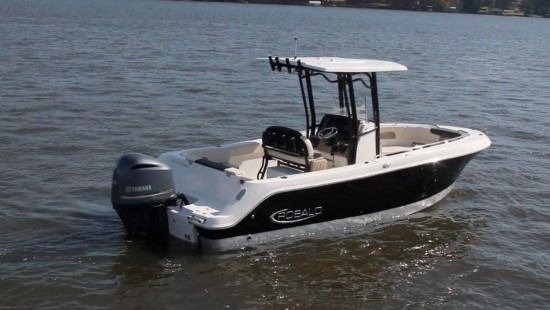
The Bow
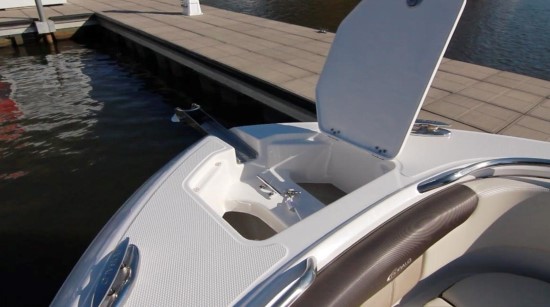
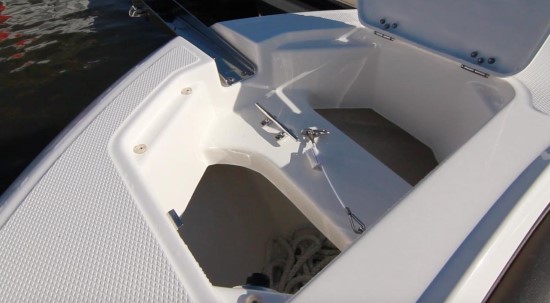
Good Design. Robalo has designed a particularly noteworthy ground tackle system in the R242EX. By putting a notch in the top of the stem, the anchor cradle has been lowered below the deck. The shank of the anchor rests on a below-deck centerline platform that also has a cleat for the anchor rode -- just as every boat should have, but these days fewer and fewer boats do.
Behind the cleat is room on the fiberglass platform for an optional electric anchor windlass. On each side are large openings to reach the anchor rode.
Robalo offers a windlass and galvanized anchor option ($2,095.00) and optional, branded pull-up cleats ($245.00).
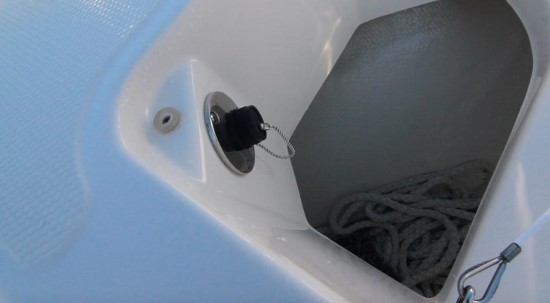
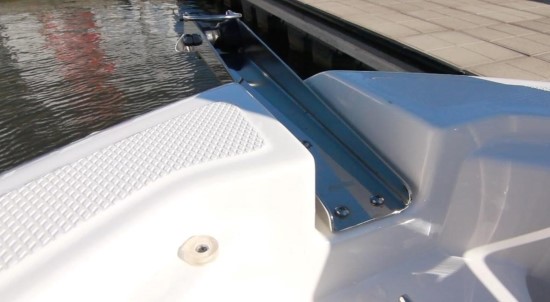
Robalo offers an optional galvanized anchor, 200’ (61 m) of rode and 10’ (3.05 m) of chain ($440.00).
Forward Cockpit
Robalo designed the forward cockpit to be multifunctional. It can be a highly social area with seating all around. With the standard backrests, the U-shaped seating converts to loungers. Add the side-mounted fiberglass table and the forward cockpit becomes an al-fresco dining area. Lower the fiberglass insert and filler cushion and the forward seating converts to a sun pad. Remove all the cushions, and the forward cockpit has a large casting platform.
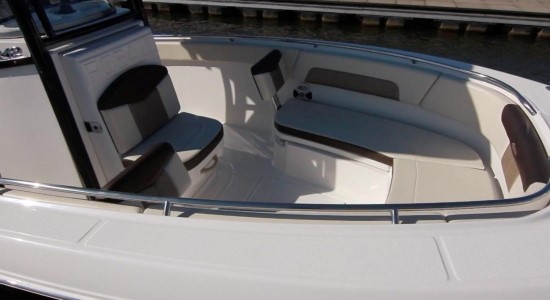
The bow rails are recessed to avoid accidental entanglements with fishing lines and nets. For the same reason, the pull-up cleats are a practical option ($245.00) for those intending to fish the R242EX.
Freeboard at the Bow. The Robalo R242EX measures 43” (109.2 cm) of freeboard at the bow and the forward-most bolsters are 27” (68.6 cm) above the deck, the cap rail tops out at 28” (71.2 cm) above the deck.
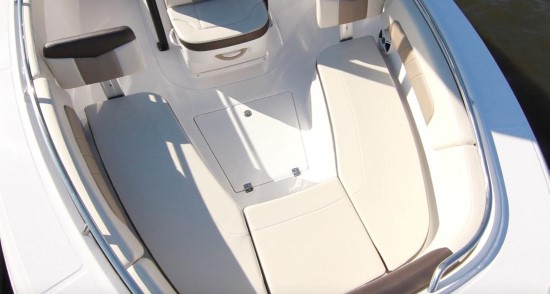
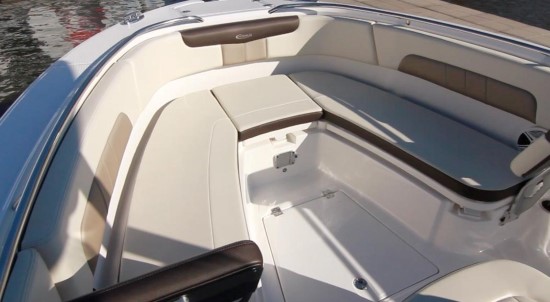
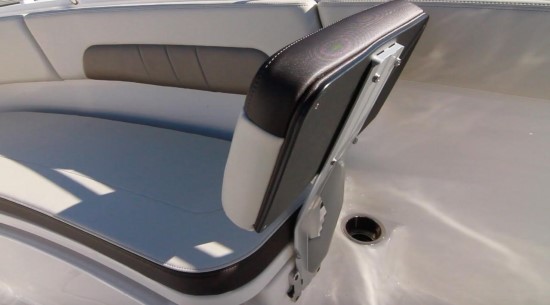
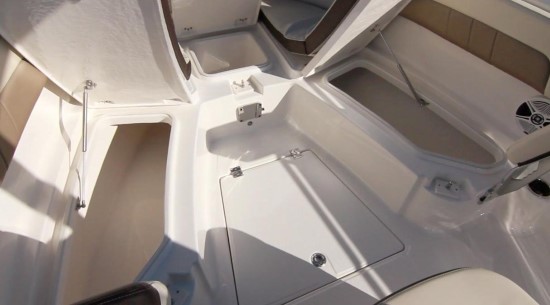
Twin 36-gallon (136.3 L), self-draining insulated fishboxes are under the port and starboard seating. Under the forward center seating is a self-draining cooler. Under the deck is additional storage shown with the hatch lid closed.
All of the cushions and the removable seat back are standard.
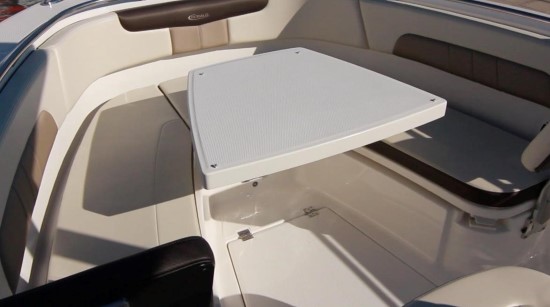
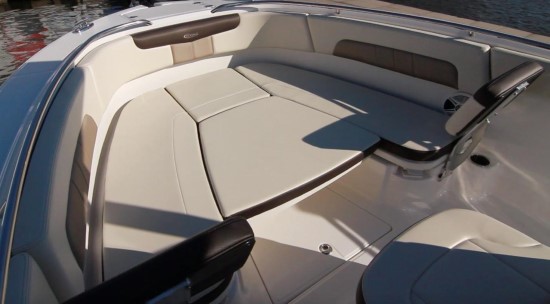
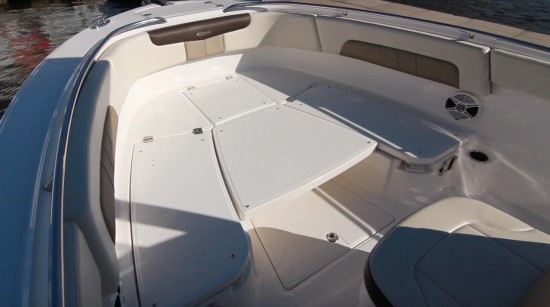
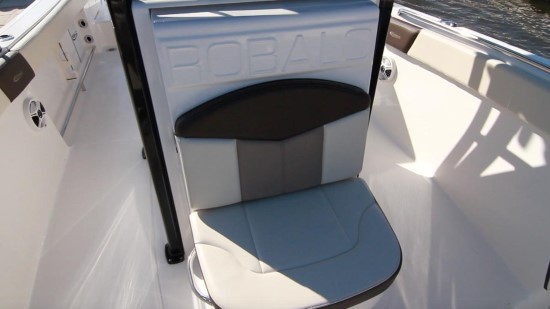
Head Compartment
The Robalo R242EX comes complete with a head compartment in the console. The compartment is accessed from the front, which makes it much easier to get in and out of than a side-mounted door. This is a major feature as far as we’re concerned.
A Porta-Potti is standard and an optional electric toilet ($1,445.00) with a holding tank is available. Add the overboard discharge capability ($1,950.00 for the package) to empty the holding tank three miles or more offshore.
Federal law states that untreated human waste can NOT be discharged in inland or coastal waters. Sewage for a portable toilet or a holding tank (Type III MSD) cannot be discharged unless the vessel is in the ocean more the three miles offshore.
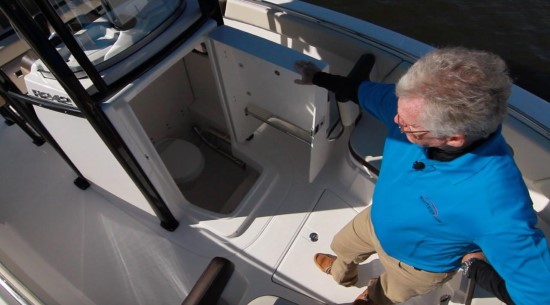
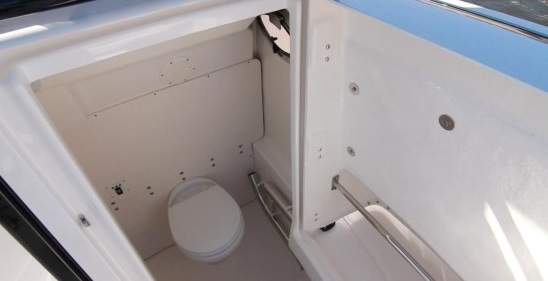
Helm
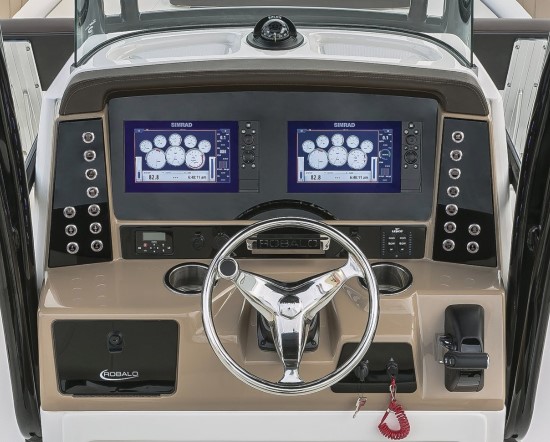
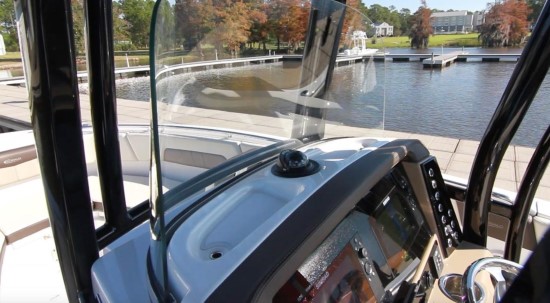
Top of the Helm Storage. On top of the helm dash are recessed, self-draining trays for storing incidentals while underway, as well as a lighted high-speed compass on the centerline.
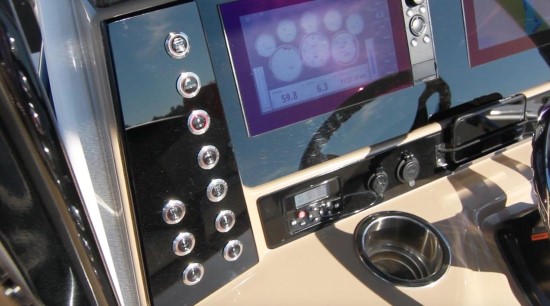
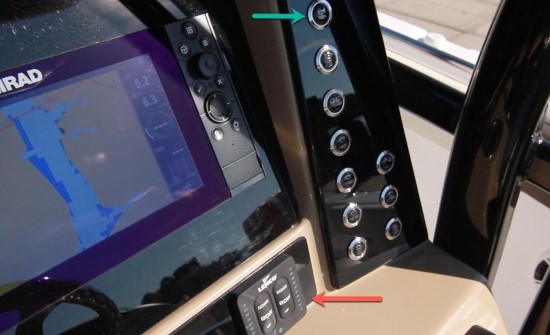
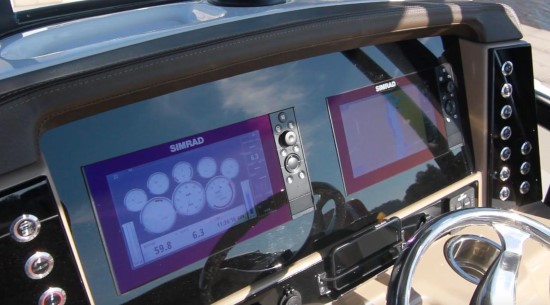
Glass-Dash. Robalo offers several configurations of the digital gauges and displays according to the engine options and owner’s preference. All are NMEA 2000 compliant that allows electronic systems to be seamlessly added.
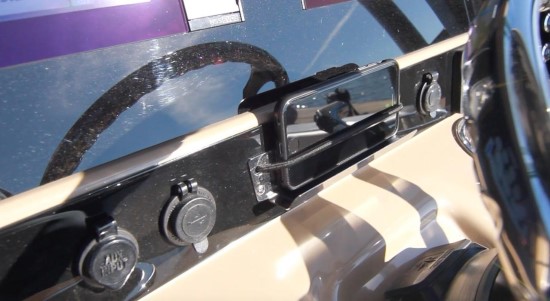
VHF Radio vs Cell Phone. Many boat owners are opting to communicate with fellow boaters, marinas, tow services, and authorities via cell phones. Although communicating with a cell phone may be simpler and clearer, it should not replace a VHF radio onboard.
VHF channel 16 is monitored by the USCG in coastal areas, as well as local towing services, marinas, and other services -- as well as fellow boaters. No boat going offshore should be without a VHF radio.
Both a cell phone and VHF radio are considered “line-of-sight” devices. Meaning, once the operator is out of sight of the shoreline, typically 14 miles offshore, the device will not pick up a signal, depending on the height of the antennae.
However, any other vessel within an approximately 14-mile radius will pick up a signal and can relay the necessary information, location, or distress. Cell phones require cell towers and they are typically restricted to being onshore. Because cell towers are raised towers, they may have a range that exceeds the VHF radio, but this is still no excuse not to have a VHF.
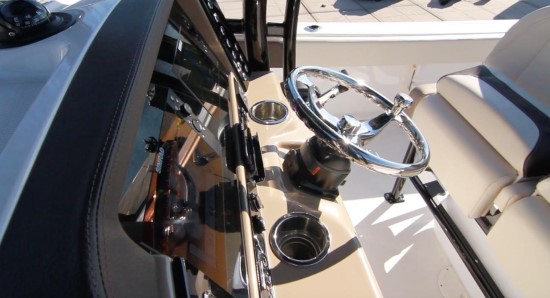
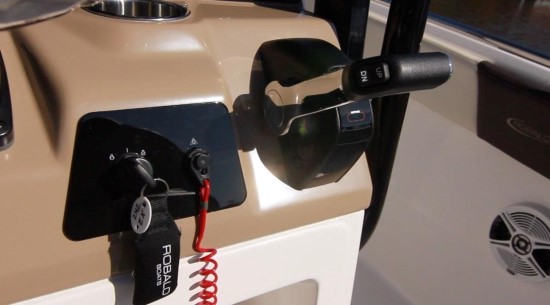
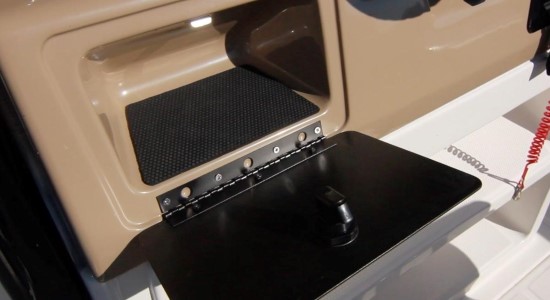
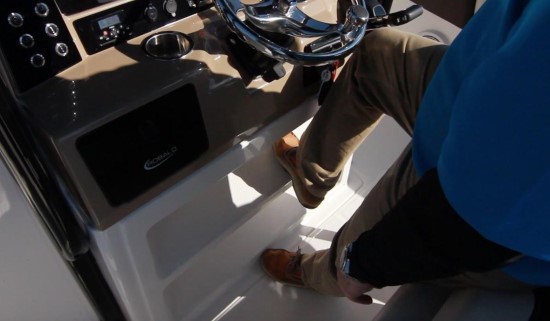
Optional Hard Top
Robalo offers several tops for the R242EX, all as options: a black Bimini top ($1,295.00), a fiberglass T-top with anodized aluminum supports and grab rails ($5,435.00), or a fiberglass T-top with powder-coated (black or white) support and grab rails ($6,095.00).
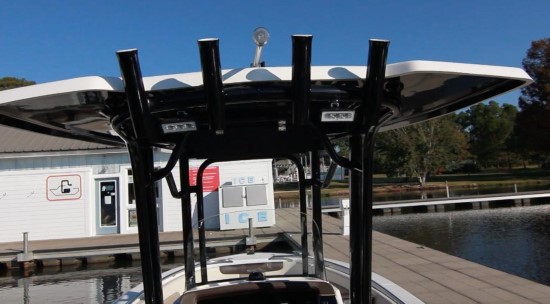
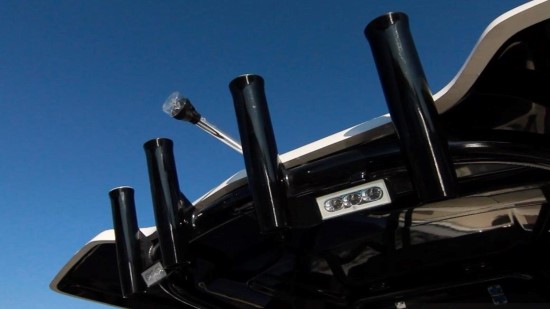
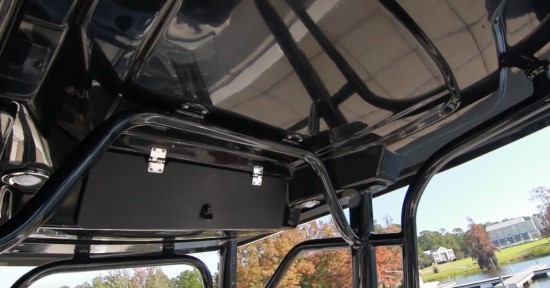
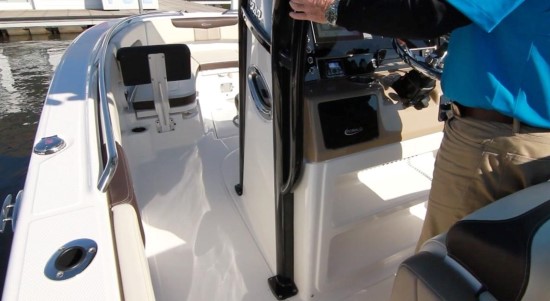
Helm Seating
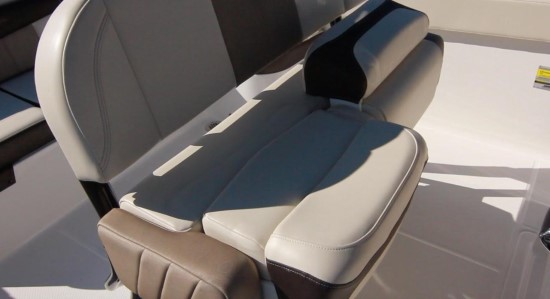
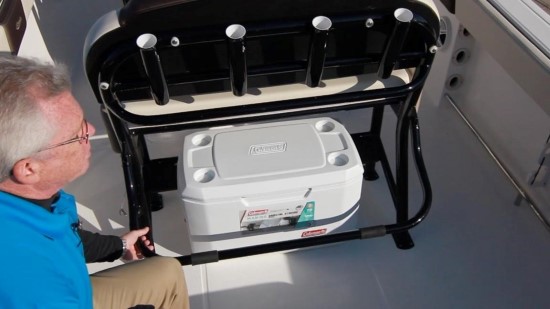
Helm Seat Cooler Retainer Bar. Robalo elected to retain the cooler in place under the helm seat with a flip-up retainer bar. The bar locks into place, keeping the cooler from sliding onto the deck. The retainer bar approach eliminates the typical retainer fixtures having to be drilled into the deck and straps on the cooler handles that wear. In addition, when it becomes necessary to replace the cooler itself, an exact fit is no longer a requirement. Any brand will work.
Aft Cockpit
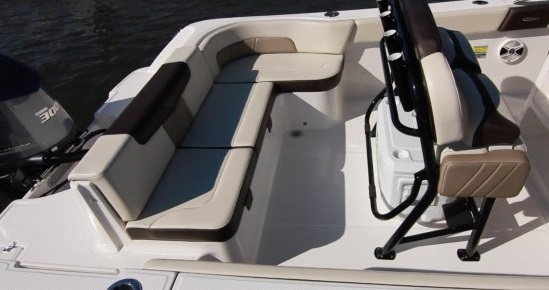
Freeboard Aft. The Robalo R242EX has a freeboard towards the stern of 33” (83.8 cm) with the aft-most bolsters measuring 21” (53.3 cm) above the deck.
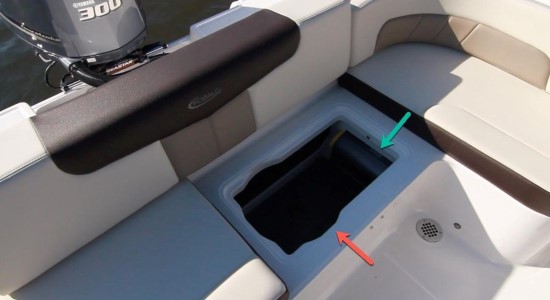
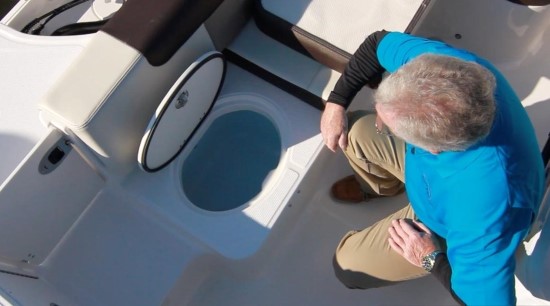
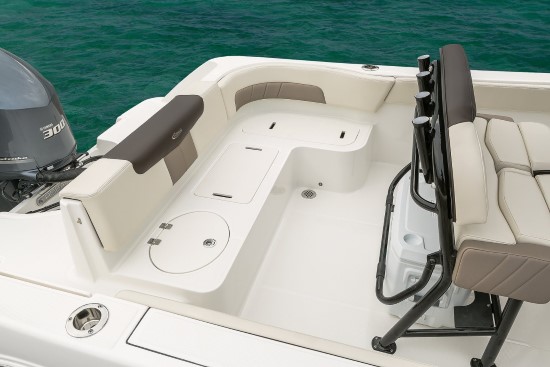
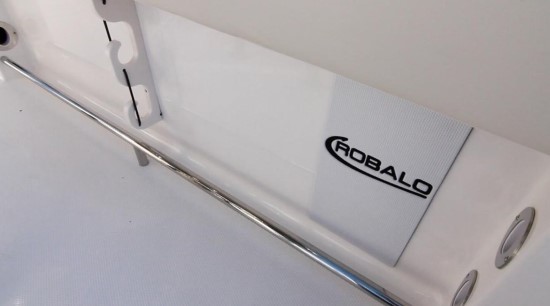
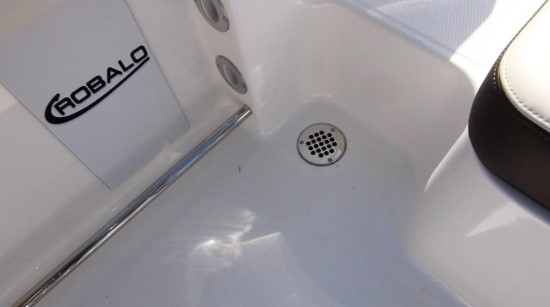

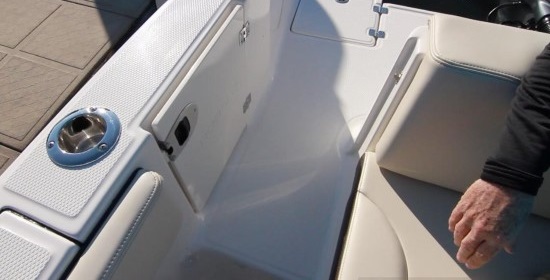
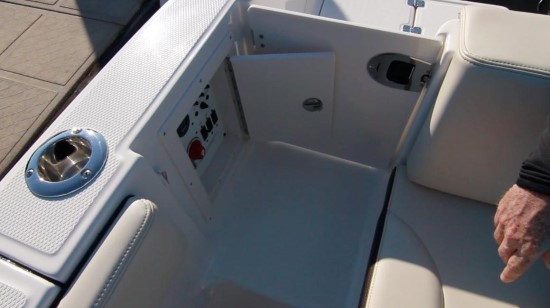
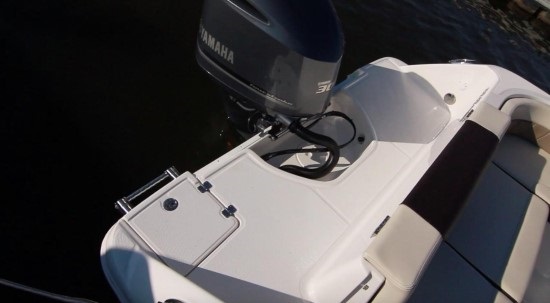
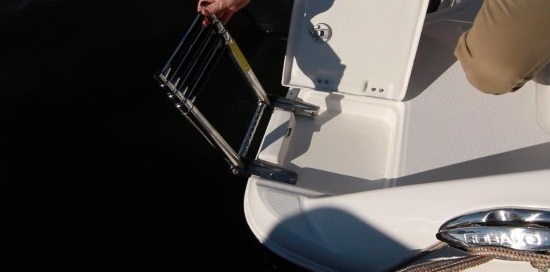
Optional Trailer
Robalo offers an optional tandem axle, aluminum trailer with galvanized wheels ($5,495.00) or the same trailer with aluminum wheels ($5,815.00).
Warranty
Robalo has a 10-year Structural Warranty. Contact Robalo for details.
We recommend that consumers read the fine print of all boat and engine warranties.
Options to Consider
Price
The MSRP is $67,995.00 with the Yamaha F250 UCA 30” shaft 4.2 L engine. Includes a five-year limited warranty on components.
Comparing the R242EX and the R242CC
Both the Robalo R242CC and R242EX are built on the same hull with essentially the same deck and center console. Nevertheless, there are five important differences between the two boats. The following are the major differences, and a few minor ones.
Since the R242 Explorer was developed after the center console version, there are several changes on the boat that are definite improvements, as one might expect in the evolution of a boat’s life, which is typically five to seven years.
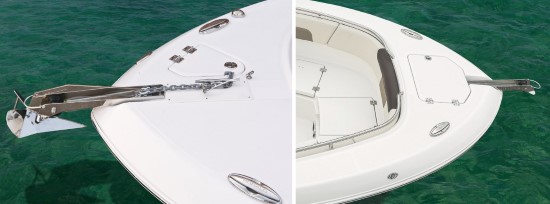
The foredeck. On the center console version, the ground tackle, cleat, and optional windlass all were placed on the deck with only the rode storage below. All of that changed in the Explorer version, which has a much cleaner foredeck, one that can be used for forward exiting to a dock, or as a diving platform when swimming from the boat. It also has a raw water washdown for the anchor and anchor rode, something the center console version does not have as standard.

Bow Seating. While the center console version had standard cushions for the bow, the removable seat backrests are optional. The seat substructure on the Explorer was made significantly wider aft to better support a person facing forward, chaise style. The result of that change allowed the insulated compartments under the seats to grow from 30 gallons (113.6 L) each on the center console version to 36 (136.3 L) gallons in the Explorer.
Also, the recessed stainless-steel handhold, which wraps around on the center console version, was eliminated on the centerline to avoid a tripping hazard when people step on the bow on the Explorer model.
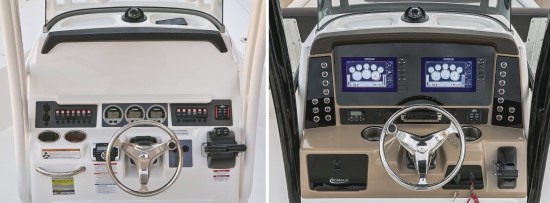
Helm Console Layout. The instrument panel on the Explorer R242 was significantly changed from the center console version. A lockable glove box which was in front of the companion seat on the console was moved up in a more convenient spot, thus allowing the sitting foot rest to be installed and used by the companion. In order to move the glove box higher up on the console, the companion hand hold was eliminated. We’d like to see it return.
Cup holders were moved to either side of the wheel, accessory switches were moved to vertical positions on either side of the glass dash, and the three individual engine monitoring readouts were moved.
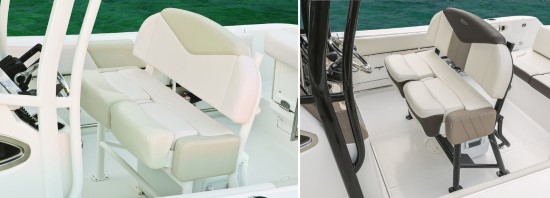
Upholstery. As can be seen in these photos, the Explorer family-friendly version has three-tone vinyl upholstery. There are seven color treatments for owners to choose from, and all combinations are tasteful and will enhance the look of the boat. Both models have optional hull gel coat colors available for only $980 extra.

Stern Seating.The center console model has the conventional fold-down seat across the transom. When folded into the transom, anglers can move right into the rear bolsters when fighting a fish. The Explorer model takes a different approach and has installed much more substantial and comfortable seating. The bottom cushions are thicker, and the seatbacks are inclined backward for comfort, not angular as on the CC version.
To port, as can be seen in the image above, the seat wraps around. In this way, a spotter can sit here and watch someone being towed.
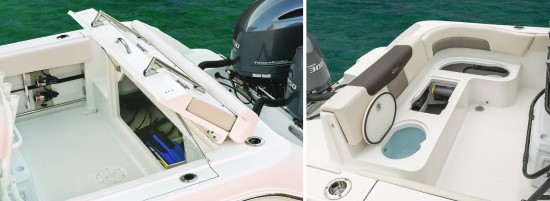
Mechanical Access and Live Well. As can be seen in the image above, the livewell has been moved from its high location in the port quarter on the center console version to below the seat on the Explorer model. In the process it went from a 20-gallon (75.7 L) livewell to one that is 16 gallons (60.6 L). Bins under the seats hold gear, and the seat back lifts up to access dedicated storage for the table on the 242 Explorer.
The center console model has a 27-gallon (102.2 L) fish box in the deck which is insulated and self-draining, which has been eliminated in the Explorer.
Observations
We think the Robalo R242EX accomplishes its mission of being a family-friendly boat. Surprisingly, Robalo did it with a highly competitive price.
As can be seen in the comparative commentary, Robalo has made the boat both more comfortable and more practical in some ways than the earlier version. Either way, consumers have a good choice and can match the boat to their kind of usage.

